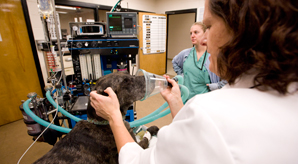Anesthesia & Pain Management
What To Expect with Pain Management
Following surgery, our team often is involved in providing pain relief for your pet. We often are consulted in the Critical Care Unit during postoperative recovery, but we also are consulted for pain management for patients with other needs, such as respiratory care or other medical situations.
Our pain management techniques and drugs always are tailored to your pet's specific needs, and our goal is to make your pet as comfortable as possible.
How Does Pain Management Work?
We use several methods to control pain after surgery:
- Local anesthetics: A local anesthetic may be used to numb the surgical site. This is a technique that can render your pet insensitive to pain in a specific area without affecting consciousness.
- Epidural anesthesia: The insertion of a tiny epidural needle or catheter into your pet's back through which a small dose of medication for pain relief can be given.
- Opiod therapy: The use of opioids to relieve pain and improve mood and functioning via the central nervous system, generally in patients with chronic pain.
- Anti-inflammatory therapy: The use of anti-inflammatory drugs to reduce inflammation.
- Integrated Therapies:
- Acupuncture: Needles are inserted into points of the body to relieve pain.
- Massage: Layers of muscle and connective tissue are manipulated with pressure, tension, and motion.
- Laser Therapy: A medical and veterinary treatment that involves monochromatic light emission for tissue healing, inflammation, and pain relief.
- Physiotherapy: This is commonly thought of as rehabilitation or physical therapy. We will work with your pet to restore maximum movement and function of the body.
We can use a variety of drugs and equipment to manage pain, depending on your pet's needs. In addition to local aesthetics, we commonly use opioids, morphine, antidepressants, and drugs for chronic pain like gabapentin and amantadine.
How Do You Know How Much Pain My Pet is In?
Every animal responds to surgery or to other medical conditions differently. In order to tailor our pain relief, we use scales to gauge Feline Pain, Canine Pain, and Equine Pain.
What is a Pain Management Appointment/Treatment Like?
After a surgery, or for other cases of pain management, we will use the appropriate pain scale to determine your pet's level of pain. This is like a physical exam, but it focuses on feeling the whole body for tight muscles, sores, range of motion, and heat, all while noting the discomfort level in your pet.
When we localize the painful area(s), we generate a plan to treat the pain. This may include drugs, physiotherapy, acupuncture, and/or massage. We will always work to educate you about ways you can help manage your pet's pain once you return home.

